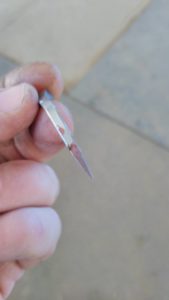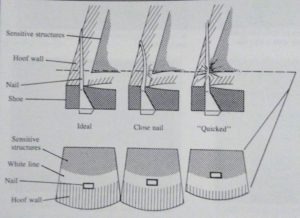Nail-Quicking
 Hoof wall thicknesses vary. There is a very small margin for error. The farrier must pay close attention to selecting and driving each nail. Not all nails are manufactured perfectly, and misshapen nails might not drive straight.
Hoof wall thicknesses vary. There is a very small margin for error. The farrier must pay close attention to selecting and driving each nail. Not all nails are manufactured perfectly, and misshapen nails might not drive straight.
However, nail quicking isn’t the only kind of quicking that can affect a horse – he can also be quicked and become lame if his sole is trimmed too close. There’s a great tendency for inexperienced farriers (and owners) to think that you get more of your money’s worth by trimming more so you don’t have to trim so often. This may also happen to a harness racehorse when people think a shorter foot helps the horse move faster. Doing this doesn’t leave enough protection for the horse’s foot – he may break over easier, but he won’t move as well. Some horse owners neglect a horse’s feet after shoes are pulled (i.e. not having horses trimmed on a regular schedule). The foot breaks apart and it becomes increasingly difficult for the farrier to drive safe nails when the horse is to be shod again.
The thinned sole does not offer enough protection for the hoof’s more sensitive inner structures, and lameness is the result. The worst problem of quicking from trimming too short is abscessing, whether from an infected deep cut or from a bruise. A quicked horse can bruise the sensitive solar corium or the bone, especially in rocky terrain, because his protection from the sole is greatly decreased. The resulting abscess may be infected with “Clostridia” bacteria, which produce gas that puts pressure on sensitive tissues.

Horses are most likely quicked because the hoof wall is extremely thin or because the sole is extremely short. Reference: Principles of Horseshoeing 3, pg 130.
Treating a quicked horse depends on the extent of the injury. If it’s severe, call your veterinarian. For minor wounds, treat conservatively. Usually, if the offending nail is discovered and removed immediately, it rarely turns into an abscess. If he’s bleeding, use a disinfectant and cover it with duct tape and a clean towel, gauze or a disposable diaper to keep more infection from getting in. When it begins to heal, cover it with a pad.
If you cover a bleeding wound without treating it, it will often abscess. If it does abscess, it’s important to have a professional open up an abscess to drain. Then you can use Epsom salts paste or a 20% ichthammol black salve to draw the infection and swelling out of a minor abscess.
A pad is probably the best remedy to protect the tender foot until the horse grows more sole for protection. But take the pads off as soon as you can so the horse doesn’t get dependent upon them. You can give him Bute for a few days so he is comfortable enough to eat and move around, but the concern then is that because he doesn’t hurt as much, he may cause more damage to the thin sole.
You can also put turpentine or Venice turpentine on the normal or quicked sole to toughen it, but be careful not to spill it on the horse’s skin because it will burn.
Nail-quicking is rare. Skilled farriers study anatomy and do all they can to avoid driving a bad nail, but it still does happen occasionally. Most of the time, these wounds are not serious and they heal spontaneously. When a horse is accidentally nail-quicked or trimmed too short, take precautions to insure that it doesn’t develop into something worse.
Related Posts
-
There is a tendency today for people to get all they can whe...Mar 13, 2012 / 0 comments
-
Equine Cushing’s disease has become more of a concern to h...Apr 05, 2018 / 0 comments
-
These last few weeks, I have been working in the tractor in ...Aug 08, 2019 / 0 comments
Blog Categories
- Anatomy
- Best Business Practices
- Conformation
- Current Events
- Customer Service
- Draft Horse Shoeing
- Equine Soundness
- Essential Anatomy Kit
- Farrier Careers
- Farrier training
- Foal soundness
- Horse Care
- Horse Foot Care
- Horse Owner Tips
- Horsemanship
- Horseshoeing
- Horseshoeing History
- Iron and Forge Work
- Student Spotlight
- Uncategorized
- Veterinary Care
Blog Archives
Contact Us
Butler Professional Horseshoeing School
495 Table Road
Crawford, NE 69339
(800) 728-3826
jacob@dougbutler.com
Subscribe to Our Blog
Get Our Free e-Book!
If you think you want to become a farrier (or know someone who does), this book can help you make that decision. Horse owners will learn the importance of choosing a qualified farrier and how to select the “right” one.
[ Get the e-Book Now! ]
- Follow:
